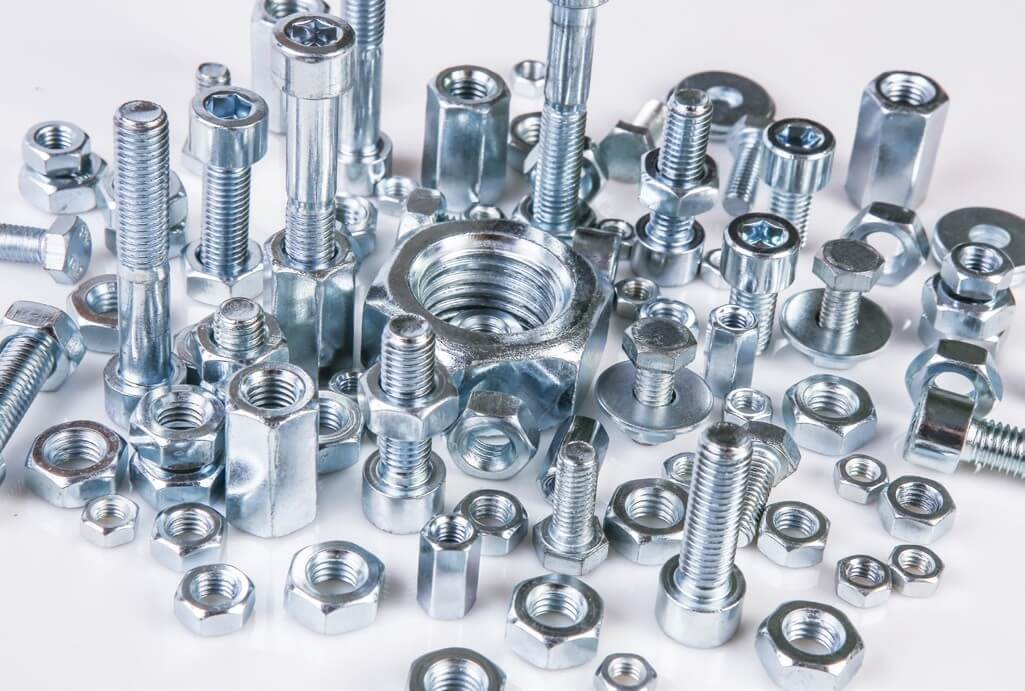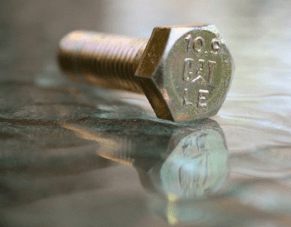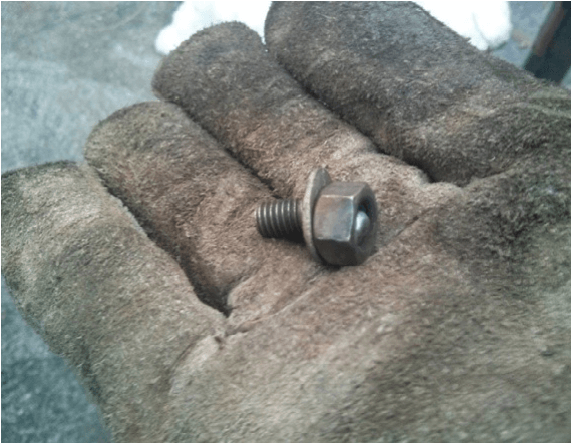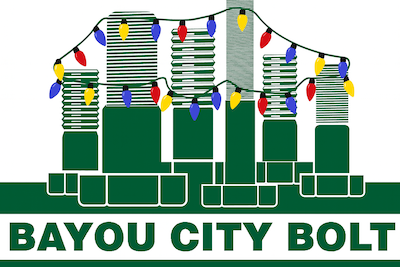 Electroplating is the process of adding a thin layer of metal to a workpiece of a different base metal. It is common for jewelry, as it is an inexpensive means to improve visual beauty by adding a layer of gold or other attractive metal.
Electroplating is the process of adding a thin layer of metal to a workpiece of a different base metal. It is common for jewelry, as it is an inexpensive means to improve visual beauty by adding a layer of gold or other attractive metal.
When it comes to mechanical fasteners such as bolts and nuts, electroplating a steel or iron component with zinc provides functionality and reliability that is more than surface deep. Steel is the most common base material for mechanical fasteners, and it provides adequate tensile and shear strength to assemble components in an expansive range of industries and applications.
However, when used alone, steel is susceptible to corrosion, chiefly in the form of oxidation. When the steel is exposed to moisture and oxygen, a chemical reaction occurs on the material surface that weakens the bond of the metal atoms and develops iron oxide, better recognized as rust. Rust degrades the bolt’s strength, dimensions and lifecycle.
From the corrosion perspective, it would be easiest to simply not use steel mechanical fasteners. For example, titanium, copper and stainless steel are all corrosion resistant. However, these materials are not as workable or abundant as steel. Instead, fasteners are coated with a thin layer of zinc, typically via electroplating, in a process known as zinc plating. Zinc-plated fasteners have been common for only about 40 years. It shows that mechanical fastener technology continues to evolve to meet modern applications and expectations, despite the basic principles being over 2,000 years old.
Safe, Inexpensive Resistance
Zinc is the ideal fastener plating material for the vast majority of outdoor and industrial applications.
Stainless steel does provide superior corrosion resistance but is generally too expensive for non-specialty applications. For decades, cadmium was the go-to plating metal as it is exceptionally corrosion resistant, is galvanically compatible with aluminum and has good lubricity, finishing and appearance characteristics. As the high, cumulative toxicity of cadmium has become better understood, its widespread use has ceased.
 As a result, zinc has become the material of first choice for corrosion protection. Zinc is abundant and workable, meaning it is relatively inexpensive to obtain and process. It is not a health risk when handled. A layer of zinc adds good lubricity to the threads of a fastener. It also adds some surface hardness to the base metal and exhibits moderate heat resistance to temperatures less than 400° F. Zinc is also a highly recyclable material, meaning it is a sustainable choice.
As a result, zinc has become the material of first choice for corrosion protection. Zinc is abundant and workable, meaning it is relatively inexpensive to obtain and process. It is not a health risk when handled. A layer of zinc adds good lubricity to the threads of a fastener. It also adds some surface hardness to the base metal and exhibits moderate heat resistance to temperatures less than 400° F. Zinc is also a highly recyclable material, meaning it is a sustainable choice.
Zinc has just a few drawbacks. The plating alone may not provide enough corrosion resistance in wet or high-humidity environments. Zinc is also chemically susceptible to acids and alkalis. Finally, there is the challenge of hydrogen embrittlement.
Electroplating preferred
Applying a layer of zinc to a metal material is generally known as “galvanization,” although that term is arguably most applicable to the hot dip galvanization manufacturing process, wherein steel is cleaned, pickled and coated with flux before immersion in a molten, 840° F or higher zinc bath. The material is quenched and the final product emerges with a thick, zinccarbonate layer.
A protective zinc layer can also be cold welded to the fastener surface. This is a mechanical process where the fastener is cleaned and then tumbled in an industrial tumbler with zinc powder, glass beads and chemicals. The successive, continuous impacts of the glass beads peen the fastener surface with zinc powder. Peening effectiveness is a product of tumbling agent selection and fastener geometry, so local layer thickness may vary, especially in part crevices. After tumbling, the part is dried and treated.
However, zinc plating is most common for fasteners and it closely resembles the electroplating process, albeit on a smaller scale. The base material is thoroughly cleaned and pickled before immersion in an acid zinc or alkaline zinc solution. The workpiece services as the cathode and a DC current is introduced to the solution. Current flowing from the anode to the cathode deposits a layer of zinc ions on the workpiece. The coating thickness and appearance is controlled by the current density, solution temperature and ionic concentration during the electrodeposition.
Electroplating is the best way to apply a protective zinc layer to fasteners for one key reason: electroplating creates a thinner, more uniform layer of zinc on the workpiece than hot dip galvanization or mechanical plating. Electroplating is less likely to skew the fine tolerances of fasteners than hot dip galvanization. Electroplating equipment is also generally inexpensive and requires less raw zinc than hot dip galvanizing. Electroplating provides an attractive surface appearance and is compatible with paints or finishes.
However, the thickened zinc layer applied via hot dip galvanization offers better corrosion resistance and can selfheal scratches and abrasions in the zinc. Although galvanized coatings typically need months of weathering to build a patina to deliver this level of corrosion resistance. For fasteners that need high corrosion or abrasion resistance, a chromate conversion coating is applied over the zinc plating for additional resilience. This additional layer passivates the zinc and protects it from white rust. As with cadmium, this material is toxic and its use is decreasing; safer trivalent chromium coatings are becoming commonplace.
Throughout the electroplating process, manufacturers need to be keenly aware of the perils of hydrogen embrittlement and how to minimize its likelihood.
 Risk factor: Hydrogen embrittlement
Risk factor: Hydrogen embrittlement
Hydrogen embrittlement is a concern when high-strength steel, such as that in many fasteners, encounters molecular or atomic hydrogen and absorbs some of it. Components plagued with hydrogen embrittlement will develop cracks and have reduced ductility and loadbearing ability. If stressed, the fastener will likely break, perhaps critically.
It is difficult to assess the risk of hydrogen embrittlement and to identify if it was the cause for a component failure. The best safeguard from hydrogen embrittlement is quality manufacturing practices.
Embrittlement is only a consideration for high-strength steels, such as those with a hardness of 40 HRC or higher or tensile strength of 150,000 ksi or higher, and a few other metals. This is because the grain structure of those metals is tight enough to trap hydrogen within, weakening the metal’s internal structure. Also, when temperatures exceed 400° F, the trapped hydrogen may react with carbon from the steel alloy. This generates miniscule pockets of methane that create internal pressures in the steel, also weakening it.
Hydrogen can be introduced to the base material during the pickling process, where an acid cleaner is applied to the workpiece to remove contaminants or descale in preparation for electroplating. The electroplating process is also a source of hydrogen for potential embrittlement. The bath solution contains metal salts and ions, but is largely composed of water. Hydrogen from the water can be deposited onto the fastener surface along with the metal ions.
There are a few methods to mitigate or relieve hydrogen embrittlement. When possible, pickling should be eliminated in favor of a mechanical cleaning technique. Inhibitors can also be added to the pickling chemicals to decrease hydrogen absorption. Mechanical plating and hot dip galvanization processes do not introduce hydrogen in the plating process. Despite this, both do require cleaning or descaling steps that may introduce hydrogen.
According to ASTM F1941, embrittlement relief baking removes hydrogen from electroplated steels. Relief baking cycle temperature and duration depends on the hardness of the fastener and is further covered by the standard.
Standardized fastener platings
Zinc-plated fasteners are ubiquitous. And due to their potential innumerable manufacturing challenges and variances, the substantial risks from unfit or unsafe fasteners are unacceptable. Standards organizations closely dictate the manufacture and performance for plated fasteners through doctrine, such as ASTM F1941 – 10, Standard Specification for Electrodeposited Coatings on Threaded Fasteners (Unified Inch Screw Threads).
The standard focuses on zinc, cadmium and zinc alloy platings for North American fasteners. Specifically:
- Important considerations for fastener customers
- Manufacturing techniques per electrodeposition
- Important specifications and test methods
- Plating tolerance accommodations
- Usage of hexavalent and trivalent chromium coatings
- General embrittlement relief baking guidelines
For example, a customer order for a fastener with a Fe/Zn-Ni 8A coating is a request for a zinc-nickel alloy coating, with a thickness of 0.0003 in and clear hexavalent chromium coating. It also specifies that a hydrogen embrittlement relief baking is recommended for eight hours, must occur within four hours of electroplating, typically at a temperature of 350° F to 450° F and be completed before a conversion coating.
ASTM F1941 is the Rosetta stone for electroplated fastener coatings. It establishes a common framework for engineers and industrial fasteners to understand technical concepts regarding the complexities of fastener coatings and ensures the quality of the products.
Selection Requires Expertise
Zinc platings, which are sometimes an afterthought, are actually an integral, fundamental fastener technology. Using this technology to its full potential requires the experience of an industrial hardware leader and supplier like Bayou City Bolt.
Bayou City Bolt is the premier hardware vendor in the southern U.S. and works with customers to understand their application needs and deliver the optimal fastener solution. With an extensive catalog and low minimums, Bayou City Bolt can pull any project together – literally and figuratively.
